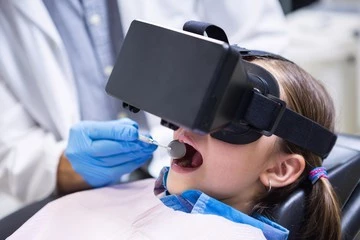Virtual Reality in Dentistry
The power of dentistry is that all technological advancements can be utilized in it. Think about 3D printing, 3D imaging, CAD/CAM, navigation, robotics and stem cell research; they are all embarked in dental science and practice.
Virtual reality (VR) is a well-known tool in gaming and entertainment industry and it has now evolved to include health-care industry as well. It can be one of the next big things in dentistry as both dentists and patients can benefit from VR.
VR models for dentists are realistic training systems created by gaming technology developers, engineering and dental/scientific researchers. It is exceptionally useful for learning about the anatomy of oral cavity, head and neck area and the specific morphology of teeth. It can be used in training young, fresh-grad dentists as well as dentists who are unfamiliar with new therapy methods or techniques. It can also help experienced dentists to update their knowledge and skills.
Dentists can practice their procedures on virtual 3D models of teeth, heads or skulls while being closely monitored by their supervisors and watched by their peers. So, it additionally can help in group learning and can provide a safe environment for practitioners to enrich their knowledge and improve their practice without fear from hurting “virtual patients.”

In such an environment, dentists are free to do mistakes and see how to correct their errors. Dentists or dental students practice their techniques with Phantom, which is a haptic input device provided with a virtual drill and controllers. The trainees use control arm/paddle to move the drill over 3D objects like teeth or jaws. In this way, they get overtime familiar with mouth cavity, teeth and tongue; and they acquire more skills and confidence to start working then on real patients.
Similarly to Phantoms, VR dental chairs can be used as training devices. The so-called haptics technology-enhanced learning (HapTEL) is used for practicing dental techniques; and it is mainly comprised of a dental chair, mirror and haptics drill to enable the trainee dentists to perform various procedures. The virtual drill is provided with a force-feedback property that enables the trainees to feel the force of the drill which is programmed to be identical to real patients. This feedback force is similar to the physical responses of the movements of joystick and it is essential in providing the sense of realism.
For patients, VR is a novel approach that makes patients get used to their dental treatments with minimal anxiety. In the US, few dentists started to provide their patients with VR headsets during dental sessions to ease their pain and anxiety. This technique can help patients to complete their therapy in a calm environment without the risk of sedatives or general anesthesia. A research study found that patients who need sophisticated pain-management techniques (such as burn victims) when treated under VR environment experienced 50% less pain compared to a control group.


